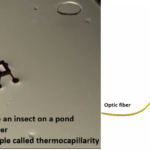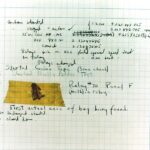How to Turn Scrap Foam and Pencil Lead Into a Working Pressure Sensor
Come realizzare un sensore di pressione con un pezzetto di un materassino in gomma piuma e la grafite di una matita.
Fonte: https://www.hackster.io/news/david-huang-s-latest-zero-cost-build-turns-scrap-foam-and-pencil-lead-into-a-working-pressure-sensor-0abebbc864d0Optimising SD Saving Events to Maximise Battery Lifetime for Arduino™/Atmega328P Data Loggers
Uno studio su tutte le tecniche che si possono mettere in campo per ridurre il consumo di una scheda a microcontrollore.
L. J. Bradley and N. G. Wright, “Optimising SD Saving Events to Maximise Battery Lifetime for Arduino™/Atmega328P Data Loggers,” in IEEE Access, vol. 8, pp. 214832-214841, 2020, doi: 10.1109/ACCESS.2020.3041373.
Fonte: https://ieeexplore.ieee.org/document/9272960Gesture/Pattern Recognition Without Camera : TOF Sensor & SPAD Array
Un lettore di comandi gestuali realizzato senza telecamera e che usa il VL53L1X TOF e un array SPAD per leggere una matrice di 16×16 punti.
Fonte: https://www.instructables.com/Dont-Feed-the-Grumpy-Hedgehog/How a Moving Platform for 3-D Printing Can Cut Waste and Costs
Una stampante 3D con il piatto di stampa suddiviso in tanti elementi quadrati di qualche centimetro di lato che si possono sollevare indipendentemente uno dall’altro. In questo modo si adatta al profilo dell’oggetto da stampare e riduce di molto il tempo e lo spreco di materiale per i supporti.
Fonte: https://viterbischool.usc.edu/news/2021/04/how-a-moving-platform-for-3-d-printing-can-cut-waste-and-costs/ThermoBots: Microrobots on the water

Piccoli oggetti che galleggiano sull’acqua e che vengono mossi tramite un raggio laser.
Fonte: https://techxplore.com/news/2021-04-thermobots-microrobots.htmlTherms-Up!
Esperimenti fatti con una normale stampante 3D a fusione passando con diversi tipi di pattern su fogli di diversi tipi di plastiche. Si creano cosi punti di fusione, dove c’è stato contatto con l’estrusore, e intercapedini. Nelle intercapedine viene poi soffiata aria per ottenere forme 3d ed oggetti che si muovono.
Fonte: https://tangible.media.mit.edu/project/thermsup/Log Book With Computer Bug

Uno dei primi bug “documentati”. Il registro si trova al National Museum of American History.
I meta-data del log book sono:
Title: Log Book With Computer Bug Smithsonian Record ID: edanmdm:nmah_334663 TITLE Log Book With Computer Bug METADATA USAGE CC0 GUID http://n2t.net/ark:/65665/ng49ca746a3-b8b7-704b-e053-15f76fa0b4fa DATA SOURCE National Museum of American History DIRECTOR Aiken, Howard Hathaway MAKER Harvard University MAKER IBM MAKER Harvard University MAKER Aiken, Howard PHYSICAL DESCRIPTION tape (overall material) PHYSICAL DESCRIPTION paper (overall material) PHYSICAL DESCRIPTION cloth (overall material) PHYSICAL DESCRIPTION ink (overall material) PHYSICAL DESCRIPTION biologicals (overall material) MEASUREMENTS overall: 1.5 cm x 48.4 cm x 29.5 cm; 9/16 in x 19 1/16 in x 11 5/8 in DESCRIPTION American engineers have been calling small flaws in machines "bugs" for over a century. Thomas Edison talked about bugs in electrical circuits in the 1870s. When the first computers were built during the early 1940s, people working on them found bugs in both the hardware of the machines and in the programs that ran them. DESCRIPTION In 1947, engineers working on the Mark II computer at Harvard University found a moth stuck in one of the components. They taped the insect in their logbook and labeled it "first actual case of bug being found." The words "bug" and "debug" soon became a standard part of the language of computer programmers. DESCRIPTION Among those working on the Mark II in 1947 was mathematician and computer programmer Grace Hopper, who later became a Navy rear admiral. This log book was probably not Hopper's, but she and the rest of the Mark II team helped popularize the use of the term computer bug and the related phrase "debug." LOCATION Currently not on view PLACE MADE United States: Massachusetts, Cambridge CREDIT LINE Transfer from United States Department of Defense, Naval Surface Warfare Center ID NUMBER 1994.0191.01 CATALOG NUMBER 1994.0191.1 ACCESSION NUMBER 1994.0191 DATE MADE 1947 OBJECT NAME log book SUBJECT Computer Bug
Immagine: Courtesy of the Naval Surface Warfare Center, Dahlgren, VA., 1988., Public domain, via Wikimedia Commons
Fonte: https://americanhistory.si.edu/collections/search/object/nmah_334663This FPC-Based Stepper Motor "Oversteps" the Mark of What We Thought Was Possible with This Tech!
La realizzazione di un motore stepper usando bobine stampate su un circuito flessibile FPC (Flexible Printed Circuit).
Fonte: https://www.hackster.io/news/this-fpc-based-stepper-motor-oversteps-the-mark-of-what-we-thought-was-possible-with-this-tech-fb61192cf6c93D-printable shredder
Un trituratore di stampe 3D stampato in 3D.
Fonte: https://hackaday.io/project/175900-3d-printable-shredderSprayable User Interfaces
Questi inchiostri conduttivi sono assolutamente da provare!
Per capire meglio il funzionamento guarda questo video: https://www.youtube.com/watch?v=UXzyFbqGYOU
Fonte: https://hcie.csail.mit.edu/research/sprayableuserinterfaces/main.html
